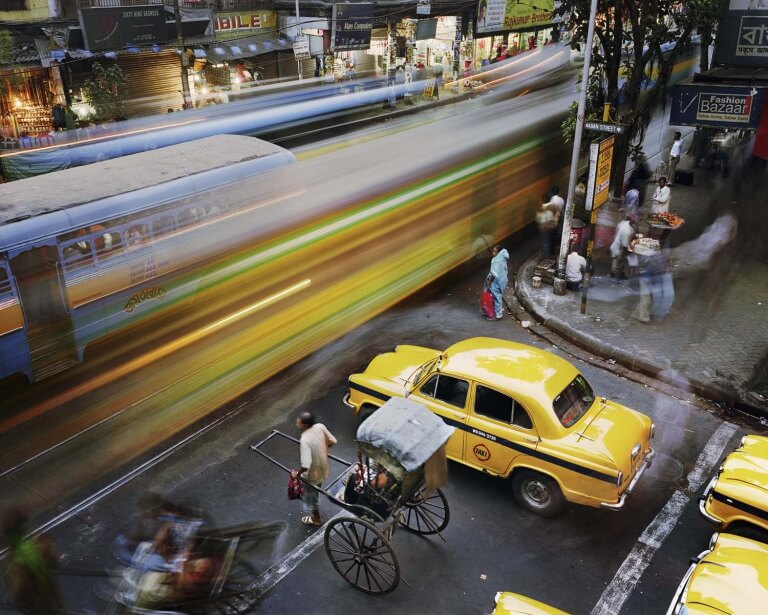Mankind may originally have been much closer to nature, but today more than half of the world’s population lives in a city. The largest cities in the world are now to be found in India and the Far East, with Tokyo – home to 38 million people – at the top. The next biggest are Delhi (25 million), Shanghai (23 million) and Mumbai (21 million). In all, 28 of the world’s cities meet the UN’s definition of a ‘megacity’: one with more than 10 million inhabitants. Globally, one in eight of us now lives in a megacity. Intrigued by this process of urbanisation, between 2007 and 2015 Martin Roemers travelled to no fewer than 22 megacities across five continents to photograph life there.
Apart from its population size the modern megacity is difficult to typify, as the conventional image of the modern, originally European or North American city has long been superseded. Today’s megacities each have their own character, in which a massive infrastructure is pervaded by small communities, colourful rituals, and rural customs. The photographs that Martin Roemers made of Guangzhou, Karachi, Lagos and Mumbai, for example, show an enormous diversity of factors, in which traditional street trades, ancient customs and old vehicles against a backdrop of modern roads, subway stations and railways depict, almost literally, today’s migration from the countryside to the city. “The differences between the photos result from the specific character of the city,” says Roemers; “the similarities result from the informal economies in which the inhabitants take part, for instance. Newcomers to a city often end up at the edges of society, and those look the same everywhere.”
How, then, to create a photographic image of such a new city? Of an enormous agglomeration with no clear core, defined chiefly by its infrastructure, and packed with a huge and ever-moving population? Years ago, in Mumbai, Martin Roemers first wondered how he might capture the experience of all that energy, chaos, movement and activity in a single image. This idea would become the seed of Metropolis. Roemers found his photographic form when he chose a high vantage point at one of the most hectic locations in the city. He took the same analogue photograph there again and again, to find out which combination of factors most effectively captured the dynamism of the city. He carefully weighed up which elements had to be included in the picture, and which ones omitted. Vehicles? A rickshaw? An interesting figure, staying still for long enough and at just the right moment? From his high viewpoint, Roemers waited patiently until everything fell into place.
Martin Roemers does not focus on the architectural silhouette of the city, on its all-too-familiar tourist spots or monuments. His focus is on the streams of human energy that make the city what it is. ‘The crowd is his element, as the air is that of birds and water of fishes,’ wrote Baudelaire. ‘For the perfect flâneur, for the passionate spectator, it is an immense joy to set up house in the heart of the multitude, amid the ebb and flow of movement, in the midst of the fugitive and the infinite.’ In contrast to the 19th century flâneur, however, Roemers does not merge with the crowd but captures its movement from above, using slow shutter speeds. His focus on megacities has created the décor for his actual subject: the human condition in the modern city. In Metropolis he has succeeded in portraying this with extraordinary precision.
Martin Roemers (1962, Oldehove) lives and works in Delft. He studied photography at the AKI ArtEZ Academy for Art and Design in Enschede. His work has been exhibited in Europe, the US, Asia and Australia. Roemers has twice won a World Press Photo Award, in 2006 and again in 2011 for Metropolis. In 2015 he was given the LensCulture Street Photography Award for Metropolis.
Martin Roemers’ earlier photo projects have engaged with the consequences of the Cold War and the life of soldiers in Kabul in such series as Kabul (2003), The Never-Ending War (2005), Relics of the Cold War (2012) and The Eyes of War (2012).
Book
The exhibition is accompanied by a photobook, Metropolis, published by Hatje Cantz (144-page bound volume, 80 colour photographs, €65). It includes texts by Ricky Burdett, Azu Nwagbogu and Els Barents, and was designed by Julia Wagner and Hans van Blommestein. ISBN 978-3-7757-40006-7. The book will be available in the museum shop.
